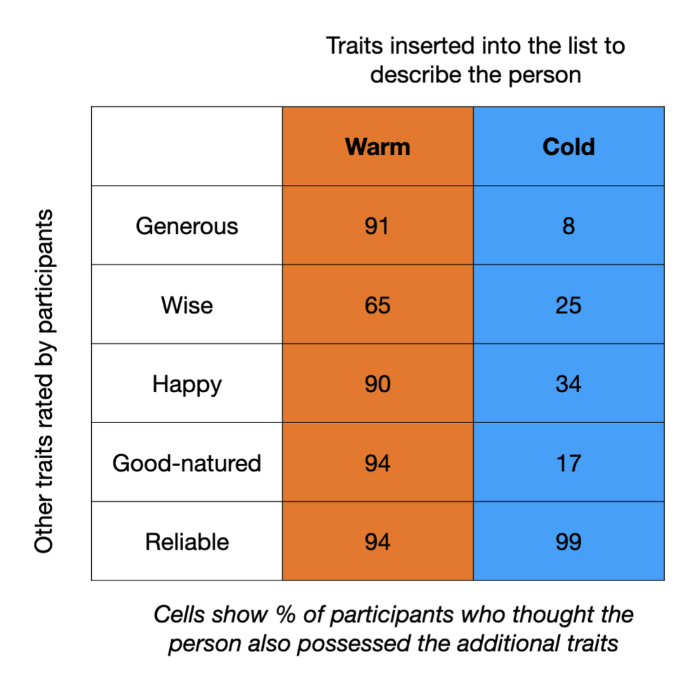Social Psychology
1/204
There's no tags or description
Looks like no tags are added yet.
Name | Mastery | Learn | Test | Matching | Spaced |
|---|
No study sessions yet.
205 Terms
social psychology
the scientific study of the thoughts, feelings and behaviour of individuals in social situations (gilovich, kilter, nisbett, 2018)
The scientific study of how people's thoughts, feelings, and behaviours are influenced by the actual, imagined, or implied presence of others (Allport, 1985)
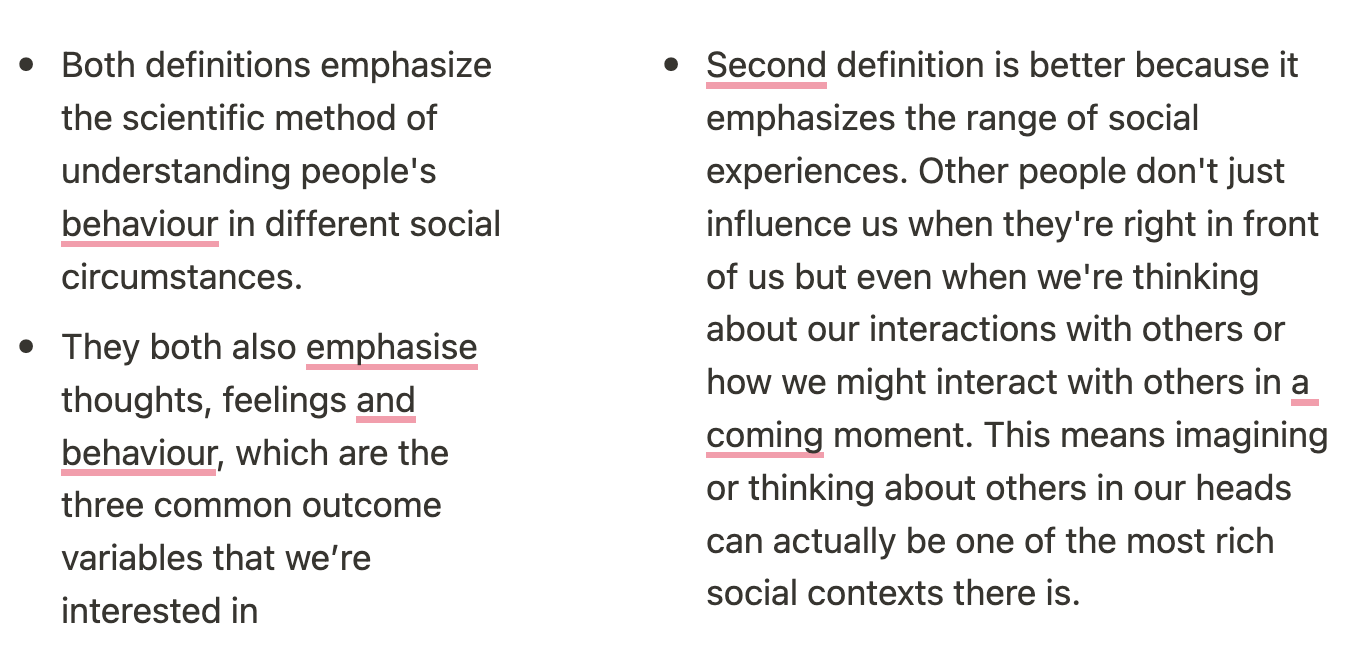
the social brain functions
understanding the self and its relations to others
forming judgements about others
understanding and making inferences about others’ mental states
perception of socially-relevant cues (faces, eye gaze, expressions, gestures)
understanding social categories and our place in them
social decision-making (to help or hurt, to trust or not)

the social brain
our brains are good at taking in and processing social information to use as an advantage as we navigate the world. It prioritizes social information over other types to assist us in operating effectively
sophisticated neural architecture for understanding our social worlds
the power of the situation
the social contexts we find ourselves in shape the way we think, feel, act
the levels of analysis
social psychologists are interested in individuals, dyads and groups
critical thinking
healthy skepticism
the power of the situation (kurt lewin, 1935)
the behaviour of people is always a function of the field of forces around them.
The field of forces for humans is the situation they find themselves in.
Human behaviour can be thought of as resulting from a combination of particular personal attributes in a particular situation
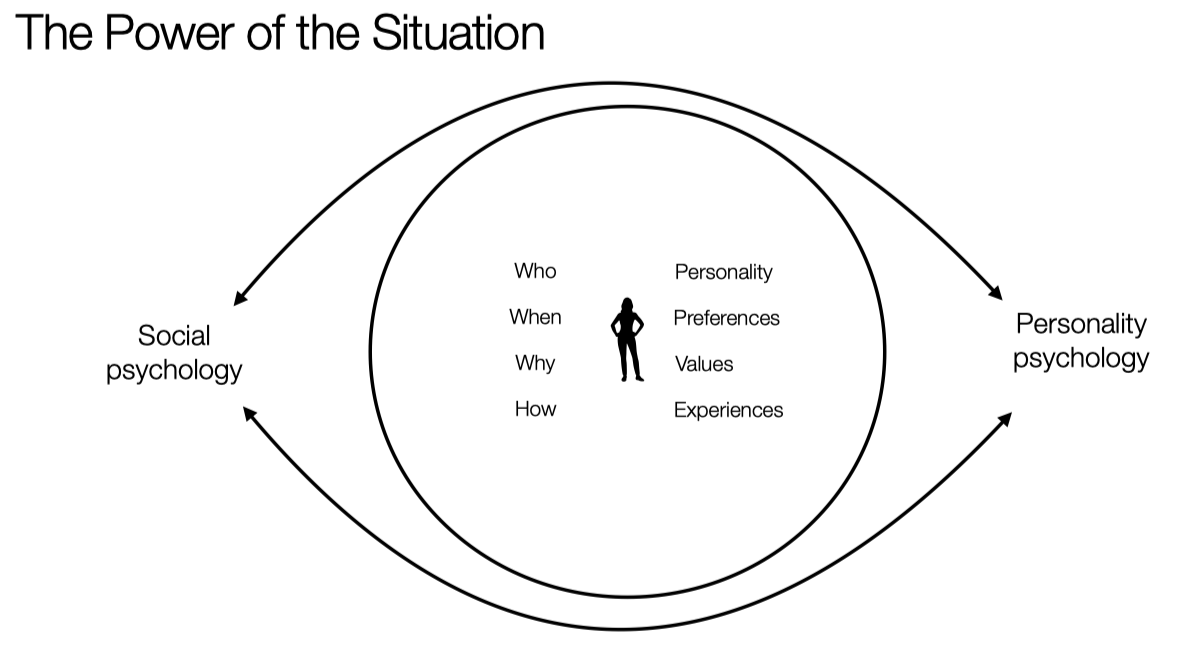
Personality and social psychology relationship
In reality, personality and social psychology reinforce one another so it's not the case of one, versus the other.
if we think about a person here, personality psychologists are interested in what makes that person unique from other people (e.g. what their personality, values are)
social psychology is concerned with that field of forces that operate around the individual. what's the situation that that person is in? what might be their motivations in that situation and how could those motivations manifest to create and give rise to different actions
levels of analysis
individual - relationship with the self (in social terms)
interpersonal - relationship with other individuals
intragroup - relationships with other people in our group
intergroup - relationships with people in different groups

levels of analysis (interpersonal)
relationship with other individuals (between two people)
levels of analysis (intragroup)
Relationships with other people in our group
what are the roles that people operate on within a given group and how can those roles be used to ensure that people are working effectively?
levels of analysis (intergroup)
Relationships with people in a different group (two or more groups interact with one another)
when does this interaction go well or more often when that goes not well, and how we can help it go better
challenges in social psychology
social psychology is the study of the context.
We don't always have a one-size-fits all answer.
Not all findings are true in every situation.
Understanding how and why context matters is part of what makes social psychology interesting.
Some social psychology studies have failed to replicate or have been reinterpreted in light of new data, validity of studies are questionnable
benefits of social psychology
gives us insight into our own and others behaviour
helps us understand the causes and consequences of current events (COVID, climate change, compliance)
gives us tools to act effectively and help others to do the same
fun to impress friends
aspects of self identity
personal identity - who we are as individuals
social identity - who we are based on our groups
cultural identity - who we are based on our upbringing
the social self
the self is a unitary and continuous awareness of oneself (morf and koole, 2012).
Our sense of self can change due to external factors (new job, moving country) or our own efforts (therapy, personality change) over time
aspects of self as being influenced by social experience
- how we think about ourselves (what are you like?)
- what (or who) we like and dislike
- habits we form
- values we adhere to
- how we (learn to) behave
introvert and extrovert social psychology study
elaborative cover story: you present yourself as an extravert or introvert in public or in person
participants rated their true selves
in the private condition, there is not much difference between these two conditions terms of how extroverted people rated themselves as truly being, maybe a slight effect but it's relatively negligible compared to public condition.
In the public condition, when people presented themselves as being more extroverted than they really were, they actually rated when they presented introverted than they really were. So this maybe suggests that in a social context can change the way we see how our personality manifests.
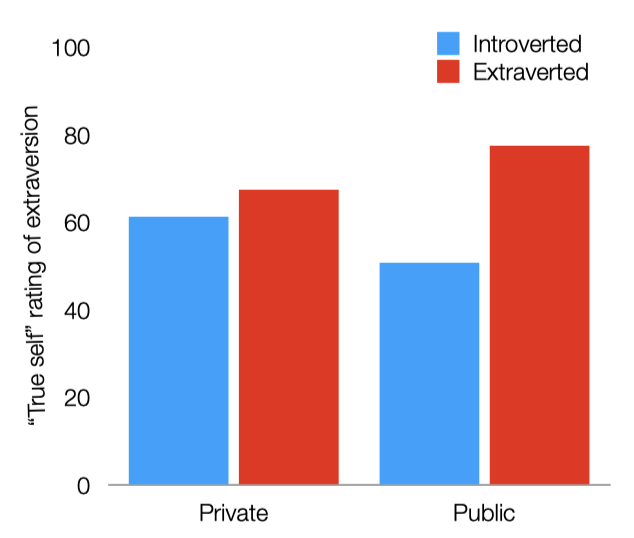
social comparisons theory (Festinger, 1954)
judgments of one's own appearance, abilities, and behaviour in relation to those of others
two types of comparisons: downward and upward (Wills, 1981)
Downward comparisons
Upward comparisons
Two assumptions of the social comparison theory
We seek to gain accurate self-evaluations (e.g. how smart/kind you are)
Comparisons with other people help us reality-check our own self-evaluations
downward comparisons (social comparison theory)
when we compare ourselves to others we think are worse than us on a particular dimension (can improve our self-evaluation, makes you feel more good and increase self esteem)
upward comparisons (social comparison theory)
when we compare ourselves to others we think are better than us on a particular dimension (can worsen our self-evaluation)
better than average effect (Alicke & Govorun, 2005; Taylor & Brown, 1988)
The tendency for individuals to view themselves positively and believe they are above average on a wide range of positive dimensions, contributing to positive self-evaluations.
Most drivers said that their driving skill was closer to expert than poor while hospitalised for being in a car accident (Preston and Harris, 1965). This does not differ when comparing a general or similar other.
Different types of social distance
Psychological distance: Loneliness
Social distance: Social network centrality
Induced distance: Rejection and discrimination
Loneliness
Subjective feeling of distress when social relations are not going how we would like (e.g your relationships arent as close as you want it to be)
Discrepancy between the level of connectedness we want to have and what we currently have.
We can be surrounded by others and still be lonely or can be alone but not feel lonely.
Loneliness is affected by ___
lack of relationship quantity (e.g., number of friends).
But is more affected by lack of relationship quality - feeling misunderstood or that relationships are not meaningful
Social isolation
a state of having minimal contact with others
Loneliness effects
Worse physical health,
greater social anxiety,
fewer social interactions,
greater depression,
worse life satisfaction,
more negative emotions

Social Distance in Social Networks
A way of quantifying social structures (a more structural way of looking at people’s social relationships is through social network analysis)
Characterises networked structures in termsof nodes (individuals within the network) and the ties that link them
Yields several measures - who knows whomin a network, popularity within a network, closeness between people in a network etc
Given the importance of connectednesswith others, lack of inclusion in a social network is detrimental for health
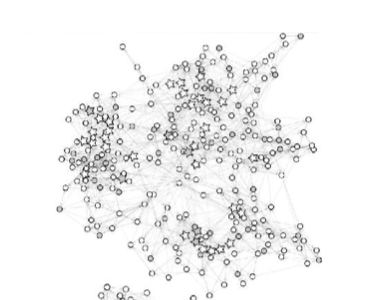
Social Networks and Physical Health: Berkman and Syme (1979) study
Greater social integration is associated with lower mortality.
a 9-year prospective study of6,928 adults in Alameda County, California
Assessed social ties in the form of marriage, friends, relatives, organisational and church membership
The fewer social ties people had, the more likely they were to die over the next 9 years
Same pattern for men and women across age groups
Social Networks and Mental Health: Cacioppo and colleagues (2009)
found people directly connected to a lonely person in a social network were 52% more likely to be lonely
Loneliness grows in networks over time extends up to a friend of a friend of a friend
Growth is particularly strong when the lonely tie is close - a friend or family member
Induction, homophily and shared environment as potential explanations
Why loneliness is contagious, Cacioppo and colleagues (2009)
Three explanations for this:
Induction: Emotion contagion within a network (the most plausible)
Homophily: Similar people are connected (like with like)
Shared environment: Exposure to the same social challenges and upheavals
Ostracism
A procedure from Ancient Greece in which a citizen was expelled from the city-state for 10 years
In modern terms, refers to social shunning
"Any act of ignoring and excluding of anindividual or group by an individual or a group"(Williams, 2001)
can lead to negative psychological effects and harm basic psychological needs
Why do we ostracise?
Group reasons:
Strengthen the group: make the group cohesive
Protect the group: correct unacceptable behaviour
Individual reasons: Individuals who ostracise feel more powerful and in control
Cyberball
Online version of a ball-tossing game.
Participants are instructed to throw a ball with other players, and are either included or excluded from receiving the ball
Still used regularly in studies today, despite the laughably simple rendering.
Effects of being excluded in cyberball are similar to "in person" ostracism- it's a very effective method of inducing ostracism
That said, some modern paradigms seek to incorporate more ecological validity in the exclusion process.
o-Cam
A modern experimental paradigm that increases the realism of the ostracism experience by simulating interactive video conversations with others through a recording
Why does ostracism hurt from an evolutionary perspective
from an evolutionary perspective, ostracism signals danger (no access to social resources)
Consequences of ostracism
basic psychological needs aren’t met
makes us feel bad
In fact, we're so sensitive to social feedback that ostracism hurts no matter who does it (e.g. person, computer, ingroup, outgroup, KKK)
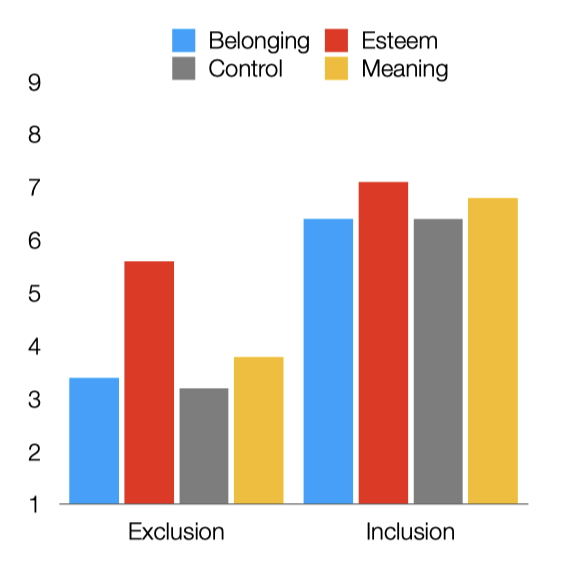
Discrimination and its consequences
How others treat us on the basis of ourgroup membership impacts on our mental and physical health through
- Stress and emotional reactions with detrimental impacts on mental health
- Negative coping responses (e.g., smoking, druguse)
- Reduced access to resources (e.g., education,employment, housing, medical care)
- Physical injury via racially-motivated assault
Stimulation hypothesis
Online interactions strengthen existing relationships and thus have a social benefit
Displacement hypothesis
Social media replaces offline, face-to-face interactions, thus incurring social costs
Pros of social media (stimulation hypothesis)
Social media can strengthen social ties
Active use to connect with others (e.g., private exchanges with others, public post) is associated with greater perceived social support and better well-being (Frison & Eggermont, 2015, Burke, 2011)
Online communication can stimulate self-disclosure, which improves relationships and well-being (Valkenberg & Peter, 2009)
Computer-mediated-communication reduces social contextual cues
People become less concerned with how others view them
Feel fewer inhibitions about disclosing information
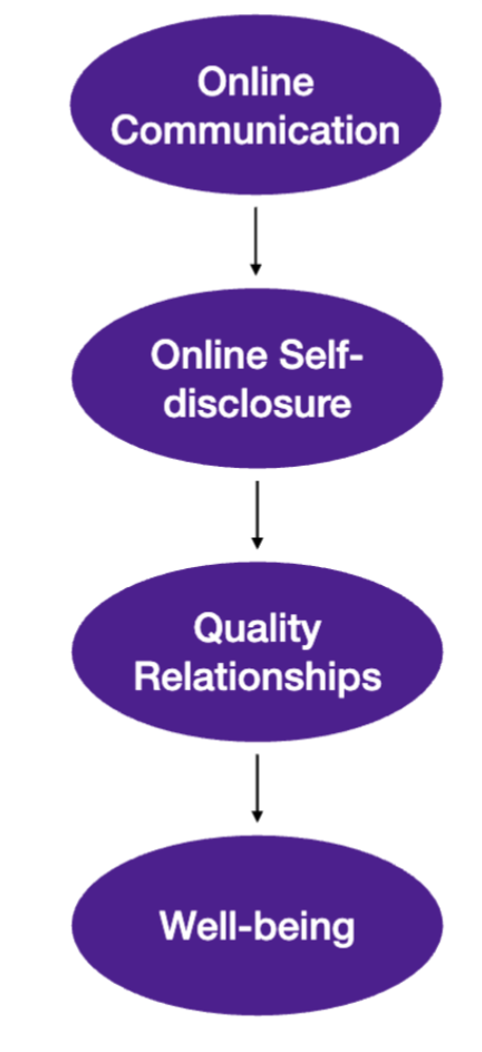
Cons of social media (displacement hypothesis)
Social media can weaken social ties
Passive use (e.g., monitoring others’ lives without direct exchanges) is associated with less perceived social support and worse well-being (Frison & Eggermont, 2015)
Accessing social media because it seems easier than communicating face-to-face increases loneliness (Teppers et al., 2014)
Social comparison is problematic
People who are on Facebook longer and more frequently tend to think others are happier and have better lives than them (Chou et al., 2012)
Social comparison anxiety on Instagram predicts greater depression (Mackson et al., 2019)
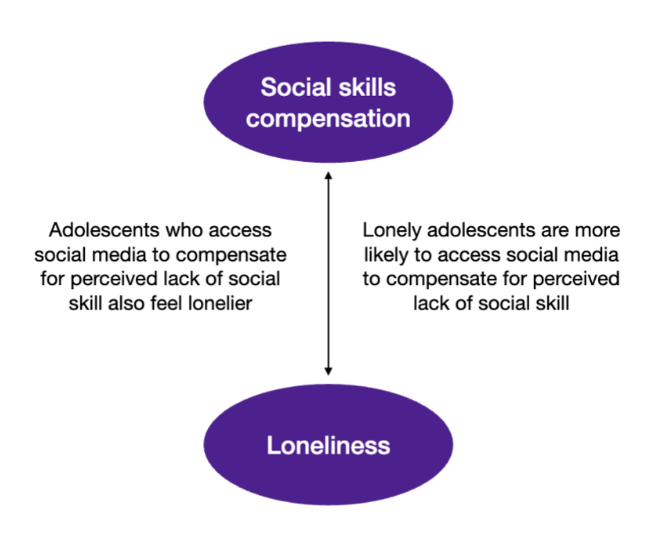
How we use social media matters
Active vs. passive: engaging socially vs. lurking
Motives for use: connect with others vs. avoid social anxiety
How is our use of social media a force for good
When actively used to enhance existing relationships and forge new social connections, social media can be a force for good
How does our use of social media harmful
When passively used to escape the social world or compare ourselves with others, social media can be harmful
Anecdata
Information based on personal intuition or observation.
Scientific Rigor
The importance of using scientific methods and replicability in social psychology research.
Critical Thinking
The ability to evaluate the quality of evidence and think skeptically in social psychology.
Social Self
The self is a unitary and continuous awareness of who one is (Morf & Koole, 2012) → the self is a holistic understanding of who you are that persists over time.
The same person who fell asleep last night and woke up this morning
This is not to say the self never changes! Our sense of self can change due to external factors (new job, moving country) or our own efforts (therapy, personality change) over time
Cover Story
A fabricated explanation given to participants in a study to prevent them from knowing the true purpose of the research.
Personality x Situation Interaction
The idea that a person's behavior is influenced by both their personal attributes and the situation they are in.
Social Identity
The part of our identity that comes from the groups we belong to and the shared characteristics we have with others.
Conceptions of social selves
The Social Me (William James, 1980)
Working self-concept (Markus & Wurf, 1987)
Self-categorisation theory
The Social Me (William James, 1980)
The concept that who we are in different social contexts can vary, and our social relationships shape our self-knowledge.
Working self-concept (Markus & Wurf, 1987)
The subset of our self-knowledge that is brought to mind in a specific context, influencing our sense of self and guiding our behavior.
The self relevant to relationships may be the mind’s prime focus in romantic contexts; the self related to competition in sports contexts
Self-categorization theory
The process of grouping ourselves and others into ingroups (groups we belong to) and outgroups (groups we don't belong to), with different identities becoming salient in different contexts (a psychology student in this lecture; a mother when homeschooling).
who we are depends on the context in which we find ourselves
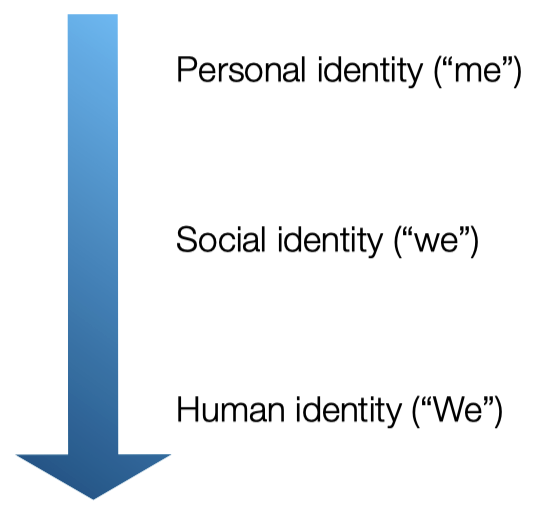
ingroups
groups we belong to
outgroups
groups we dont belong to
Cultural identity
Our sense of self derived from the groups we belong to that have a distinct culture, which can be fostered directly through socialization efforts or indirectly through exposure to different ways of life.
A form of social identity, but one that is often with us from the day we are born and encompasses a total way of life and the way we view the world
Cultural self-construal ways
individualist or independent
collectivist or interdependent
Individualist / Independent self-construal
The cultural perspective that emphasizes the self as an autonomous entity separate from others, promoting individual goals and uniqueness.
My environment should change to fit me
Many Western countries: USA, Australia, UK
Separate from social context
Be unique, express yourself
Promote your own goals
Say “what’s on your mind”
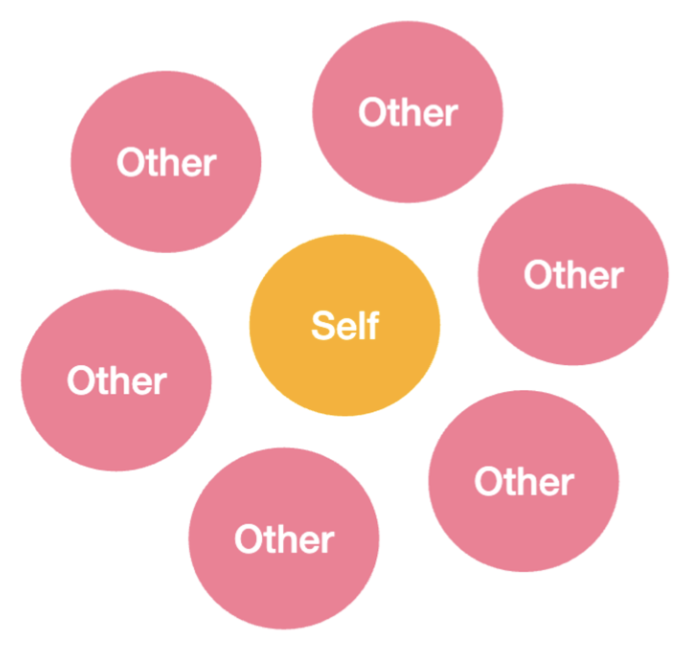
Collectivist / Interdependent self-construal
The cultural perspective that emphasizes the self as fundamentally connected to others, promoting fitting in a community and fulfilling appropriate roles.
I should change to fit my environment
Many East Asian, South Asian, African and Latin American countries
Connected with social context
Fit in, occupy your proper place
Promote others’ goals, sometimes in the expense of your own
“Read others’ minds”
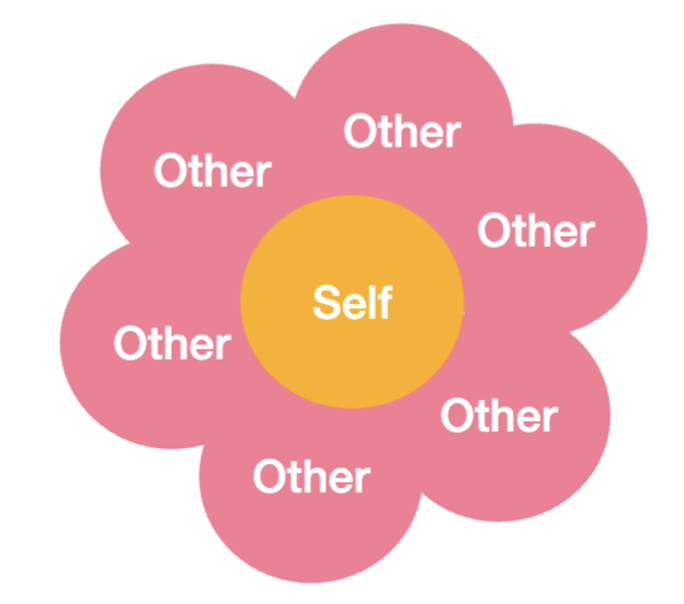
Construal
The interpretation or perception of a thing. in the context of the self, it refers to the interpretation or perception of the self.
Who Am I exercise Findings (Kuhn & McPartland, 1954)
List 20 statements that describe who you are
Americans’ self-descriptions tend to be context-free responses about traits and preferences (“I like camping”; “Hard working”)
Responses by people from interdependent cultures tend to be context dependent and refer to relationships (“I’m serious at work”; “I’m Jan’s friend”)

Who Am I exercise Findings in Kenya (Ma & Schoeneman, 1997)
Kenya is a collectivist country
There are within country differences:
Undergraduate students living in Nairobi with greater exposure to Western culture and being educated in Western tradition
Traditional Maasai herding peoples who had very little contact with Western principles
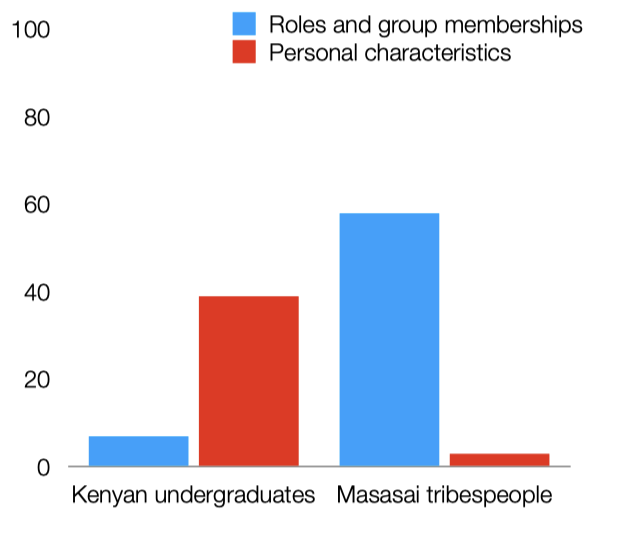
Basic psychological needs (Williams, 2009)
Belonging: to be accepted by others
Self-esteem: to be liked by others
Control: to be capable of achieving goals
Meaning: to have relevance in the world
Connection with others fosters human basic psychological needs (Greenaway et al., 2016)
People were asked to remember a time they gained or lost an important identity or group membership
Then reflected on how this event affected basic needs
black dot is the average/means of all the four needs
in the condition where people reflected on losing a group, those needs were rated as being less met than in a baseline condition when people were just rating it at that current moment whereas in the gaining group condition, those needs were actually inflated or increased relative to the baseline condition. So what this suggests is being more socially connected to others is beneficial for us that it helps meet these four basic needs
some research suggests that these different needs might reinforce one another
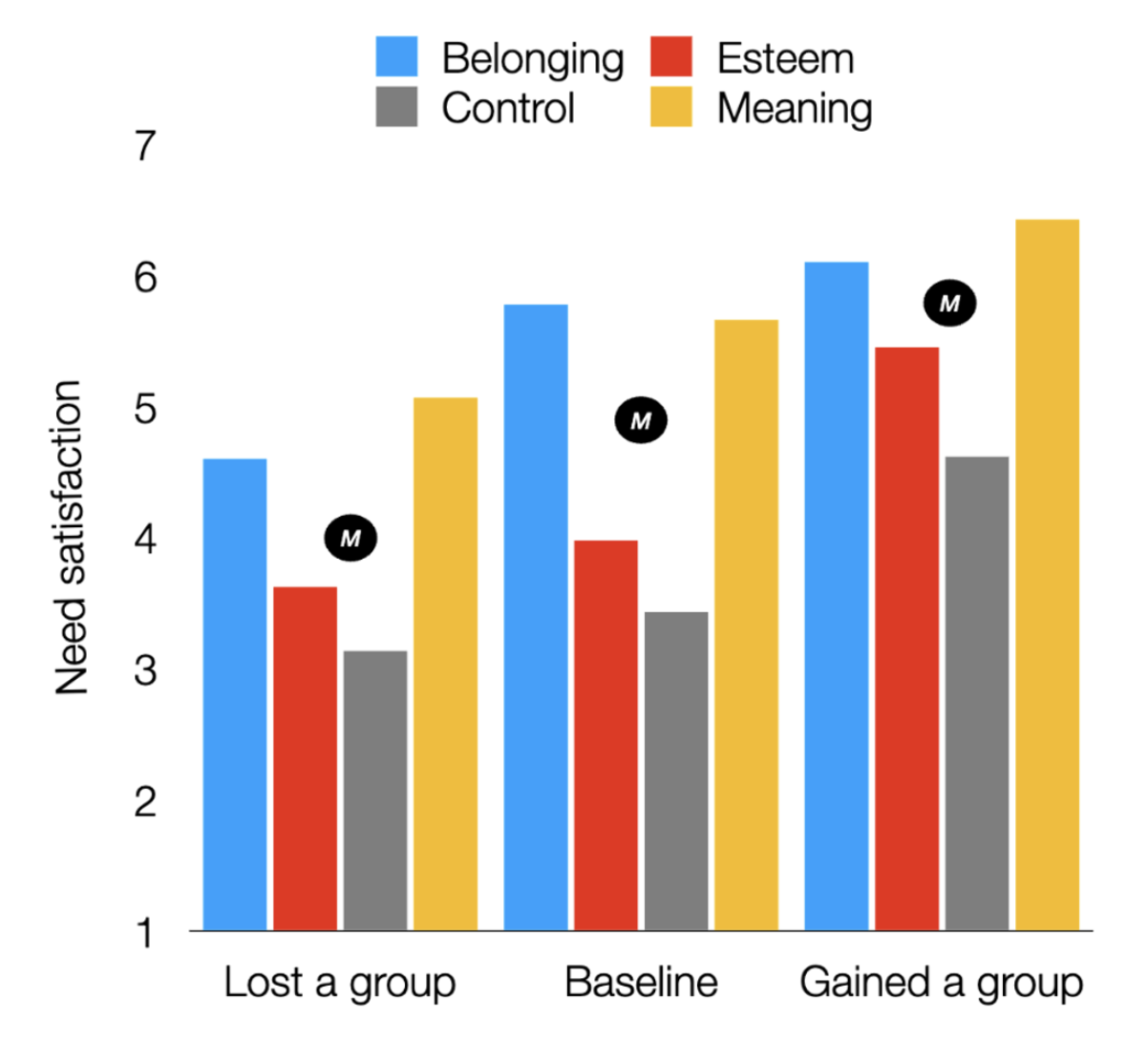
Sociometer Hypothesis (Leary et al., 1995)
Things that make us feel good about ourselves (self-esteem) are also the things that make others accept and like us (belonging). High self esteem signals social inclusion, low self esteem signals social exclusion. Self-esteem cues us when we need to attend to and shore up our social bonds
Leary and colleagues argue we don’t need self-esteem for personal reasons, just social reasons → that we need to be connected to others
Self-esteem
A measure of our perceived social standing with others, with high self-esteem indicating social inclusion and low self-esteem indicating social exclusion.
Social Comparisons
The process of comparing oneself to others to gain accurate self-evaluations, which can be either upward (comparing to those perceived as better) or downward (comparing to those perceived as worse).
Reflection
A process in the Self-Evaluation Maintenance Model where other people's success improves our self-evaluation, typically in domains not relevant to the self.
My sister won her rowing race at 6am in the freezing Melbourne winter - I feel so good!
Comparison
A process in the Self-Evaluation Maintenance Model where other people's success worsens our self-evaluation, typically in domains relevant to the self.
My friend got the highest score on the MBB2 assignment - I need to eat my feelings
BIRG-ing
Basking in Reflected Glory, a motive for enhancement where we align ourselves publicly with successful others to feel good about the groups we belong to. E.g. Wearing team clothing, saying “we” (Cialdini et al., 1976)
CORF-ing
Cutting Off Reflected Failure, a motive for protection where we distance ourselves publicly from those who have failed to avoid feeling bad. E.g. Taking down signs of support (Boen et al., 2002)
Loneliness
A subjective feeling of distress when social relations do not meet the desired level of connectedness, influenced by both relationship quantity and quality.
Social Distance
A measure in social network analysis that quantifies the structure of social relationships, including who knows whom, popularity, and closeness between individuals.
Making a first impression
The initial perception or judgment formed about a person upon meeting them for the first time.
Can do so using:
snap judgements
thin slices
person perception
Snap judgements
Quick and instantaneous impressions formed about others based on limited information or brief interactions.
Snap judgements and Willis & Todorov (2006) study
showed people faces and had them rate those faces on a range of traits (likeable, competent, honest, aggressive, extraverted etc)
Some participants rated at their own pace to weigh up all the different information and figure out what impression we have of them (“gold standard” comparison)
Others rated after seeing the faces for 1 second, half a second, or 100 ms
people were able to make snap judgements about faces similar to those who had much time

Impressions that make a difference in voting behaviour
Politicians with faces judged to be more competent after 1 second exposure were 69% more likely to win their election (Todorov, Mandisodza, Goren, & Hall, 2005)
Replicates when the faces are shown for 1 tenth of a second (Ballew & Todorov, 2007)
Snap competence judgements made before an election accurately predict who will win that election in 70% of cases (Ballew & Todorov, 2007)
Of course, snap judgements of competence aren’t necessarily based in reality but they can affect perceivers’ thoughts and behaviour
Thin slicing
The ability to form accurate impressions about others based on small snippets of information or short interactions.
Thin Slicing and Ambady and Rosenthal (1993) study
had participants form judgements of university lecturers and high school teachers
The catch: judgements were based on 10 second videos of the person teaching
Participant judgements were compared against student evaluations (lecturer) and principal ratings (high school teacher)
people’s ratings of the person they knew very well vs the ratings participants gave that didn't know them were very similar
the lower correlation in the high school condition may be because its a principal who may not know the teacher very well as they don't go to every class unlike students with a lecturer
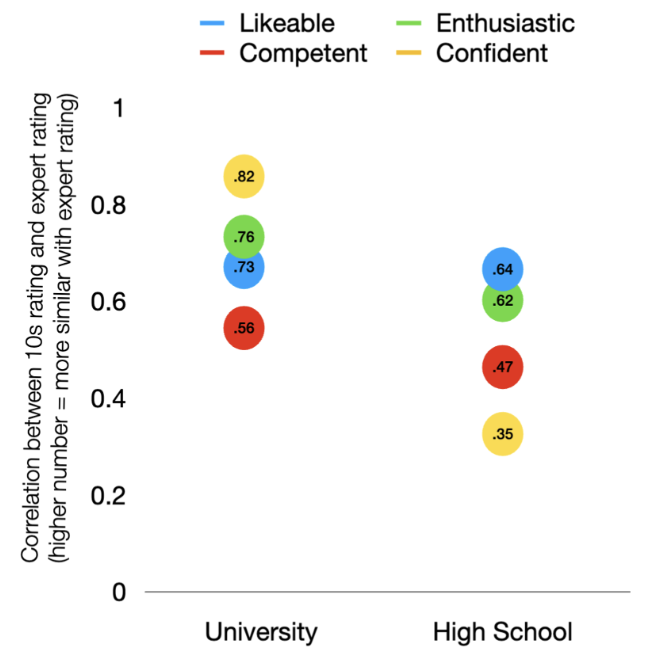
Person perception
The process of forming impressions or judgments about others based on two dimensions: warmth and competence
Warmth
Traits that help us assess others’ intent in a social context
“Are this person’s intentions toward me good or bad?”
Friendly, kind, sincere, generous, helpful, tolerant, understanding, fair, honest
Competence
Traits that help us assess others’ ability to act on their intent, their ability to achieve goals
“Can this person carry out their intentions toward me?”
Skill, efficiency, confidence, intelligence, clever, knowledgeable, foresighted
Fundamental dimensions of warmth and competence
Cold and incompetent
Cold and competent
Warm and incompetent
Warm and competent
Continuum we tend to rate people on
Is warmth or competence judgements primary?
Warmth judgements appear to be primary, and are made more quickly than competence judgements (Fiske, 2006)
“From an evolutionary perspective, the primacy of warmth is fitting because another person’s intent for good or ill is more important to survival than whether the other person can act on those intentions”
Innuendo effect
a phenomenon where you form impressions of someone on that judgement that you don't know very much about, and you tend to think that the person is lacking in that particular domain.
Reason for innuendo effect
We like to form well-rounded impressions of people, meaning we may infer qualities about people if we don’t have concrete evidence about those qualities
Kervyn et al. (2012) and the “innuendo effect”
Participants hear certain things about pat, are divided to groups (warm, competent, control), and asked to rate pat on warmth and competent
Participants assume that pat is lacking in an area that they didn’t hear about
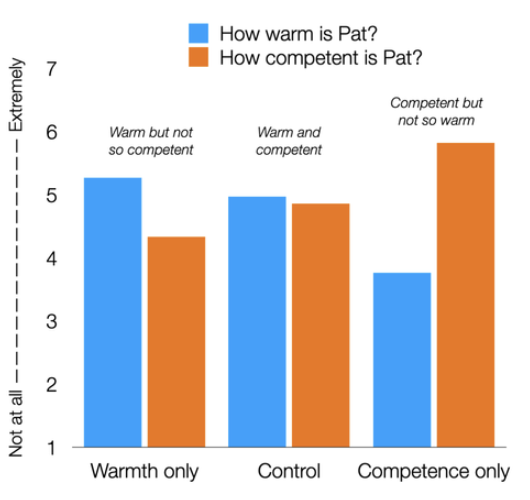
Impression formation
The process by which people combine information about others to form an overall judgment or impression of them.
Two ways in which impressions are updated
Algebraically
Configurationally
Algebraic models
Models of impression formation that involve mechanically combining information about a person to form an overall impression, such as summative, averaging, and weighted averaging models.
Algebraic model (Summative) criticism
Certain traits can have an outsized influence on the impression that we form of someone because we just add them up regardless of their weightage
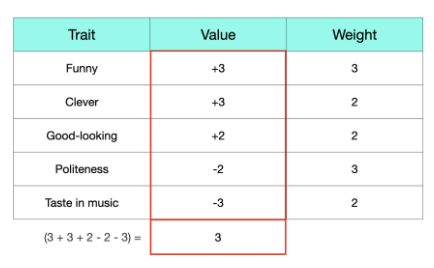
Algebraic model (Averaging) criticism
any individual value that we assign them is not gonna have as much of an outsized influence on how we see people
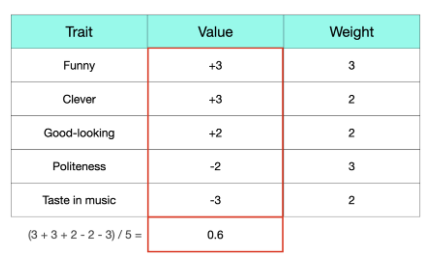
Algebraic model (weighted average) criticism
a criticism against these different algebraic models is that its more of a calculated way of making impressions on others, people don't really do that
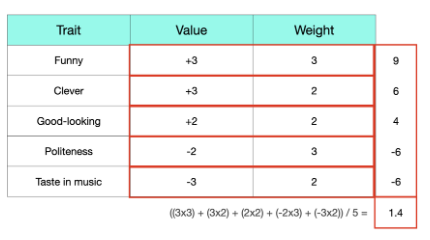
Configurational model
A model of impression formation that suggests people combine information about others into an overall impression that may differ from the simple sum of individual traits, based on Gestalt principles.
Two types of traits we rate people based on in configurational model
Central traits: influential in impression formation (traits that hold a lot of weight due to context)
Peripheral traits: less influential in impression formation
What a central or peripheral trait is depends on the person making the judgement and the situation/context they're in → impression of someone for job interview vs friend is different
Impression formation and Asch (1946)
tested how small changes to a description of an individual might affect overall impression formation
A person was described as:
Intelligent, skilful, industrious, warm, determined, practical, cautious
Intelligent, skilful, industrious, cold, determined, practical, cautious
Participants asked how likely the person was to also possess other traits
The difference is very big despite one difference of a warm and cold trait
